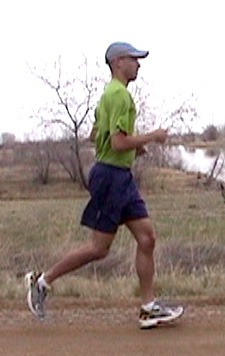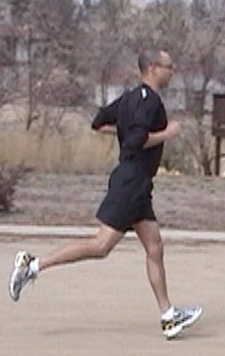Hip flexor pain can range from a feeling of tightness and slight ache in front of the hip joint, to severe pain in the groin that extends up into the lower abdomen. It can end your running, make it hard to lift your leg or legs, hard to get in and out of a car, hard to climb stairs, and painful to walk.
The Hip Flexor refers to the Illiopsoas muscle. This muscle is a combination of the Psoas Major which has its origin on the bodies of the 12th thoracic vertebra and all the Lumbar vertebra, extends vertically down over the anterior groin area where it merges with the Illiacus muscles and then inserts on the inside of the femur on the lesser trochanter. Pain or discomfort can be felt all along the Psoas muscle, but most often is in the area from the upper rim of the pelvis down to where the muscle attaches on the inside the femur in the groin area.
Causes and Considerations
This injury is deeply rooted in our posture in terms of pelvic alignment with the torso, and curvature of the lumbar spine. With an anterior pelvic tilt and increased curvature of the lumbar spine, the hip flexor is short and tight. Tightness also develops around the pelvis and in the low back that is accompanied by muscle imbalances and immobility. To find the root cause of this hip flexor tightness one needs to study postural habits: how and why they are reinforced. Working to correct postural habits can cover a lot of ground in healing this injury, as well as ensure a more permanent result. Work to improve running form can be used as a means to correct the posture and reduce the pain, especially if poor running technique has generated the symptoms.
Hip flexor pain can range from a feeling of tightness and slight ache in front of the hip joint, to severe pain in the groin that extends up into the lower abdomen. It can end your running, make it hard to lift your leg or legs, hard to get in and out of a car, hard to climb stairs, and painful to walk.
The Hip Flexor refers to the Illiopsoas muscle. This muscle is a combination of the Psoas Major which has its origin on the bodies of the 12th thoracic vertebra and all the Lumbar vertebra, extends vertically down over the anterior groin area where it merges with the Illiacus muscles and then inserts on the inside of the femur on the lesser trochanter. Pain or discomfort can be felt all along the Psoas muscle, but most often is in the area from the upper rim of the pelvis down to where the muscle attaches on the inside the femur in the groin area.
Causes and Considerations
This injury is deeply rooted in our posture in terms of pelvic alignment with the torso, and curvature of the lumbar spine. With an anterior pelvic tilt and increased curvature of the lumbar spine, the hip flexor is short and tight. Tightness also develops around the pelvis and in the low back that is accompanied by muscle imbalances and immobility. To find the root cause of this hip flexor tightness one needs to study postural habits: how and why they are reinforced. Working to correct postural habits can cover a lot of ground in healing this injury, as well as ensure a more permanent result. Work to improve running form can be used as a means to correct the posture and reduce the pain, especially if poor running technique has generated the symptoms.


An important thing to consider with running is the role that the hip flexor plays. Optimally it is free to move the hips forward and add more lift to the thigh in faster running. What I have seen over and over with runners that have this injury is tight hip flexors that are used to Statically Stabilize, which results in lack of mobility of the core. Chest is held high and back, there is a bow in the back, and the hips are back. Legs then do the work of running. However if a runner then pushes to get more speed from leg lift, the Psoas muscle is forced to both statically stabilize and to powerfully move the body forward. It gets stressed out.
Healing the Painful Hip Flexor
The important thing to understand is that the hip flexors, in concert with other postural stabilizers, are designed to move us forward with a Dynamic Stabilization of the Core and torso, not a static one. The dynamic balance is achieved by the opposition of shoulder and pelvic rotation. This opposition in movement stabilizes and balances us when we walk and run, not the holding, tightness and inevitable rigidity that is hallmark of the static stabilization. We need to be loose and fluid in our movement.
To heal a painful hip flexor, it needs release. But clinical release will only work for so long until it is asked to perform the two divergent tasks I just wrote about. The long term and true resolution of this problem is to learn how to get release of the hip flexor when walking and running. When you can do this it not only helps your running improve and your pain to fade, but it also helps overall posture.
Most information you find on the web will tell you how much time you have to take off of running depending on the level of the strain to the hip flexor. With “Healing on the Run” methods you shouldn’t have to take off any time unless it is severe. But you may need some professional help.
Some things to try while running:
- Before you start, walk a little and notice where your pelvis is in relation to your torso and tuck it gently under you. Relax your chest down and notice your upright alignment.
- Start out very easy with little steps and relax the chest down and the shoulder forward. Tuck your pelvis gently under you and again notice your alignment.
- Start to pick up your pace gradually and shorten your stride out front. Focus on your feet lingering on the ground just a brief second so that they glide out behind you. This will put the hip flexor into a dynamic stretch with each step.
- It is important to feel your pelvis under your torso and stay relaxed as you are attempting to transition out of a static stabilization pattern into a dynamic one. Any holding of tension will limit mobility.
- Get friends or a professional to video you so you can see if you are able to get good alignment of the torso and the pelvis and relaxation.
Visit Rehabilitation Coaching / Recovery Running to see how Radiant Running can help you get past your injury.
Original article and pictures take radiantrunning.com site
Комментариев нет:
Отправить комментарий